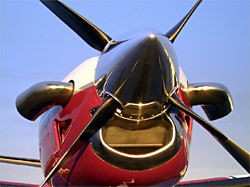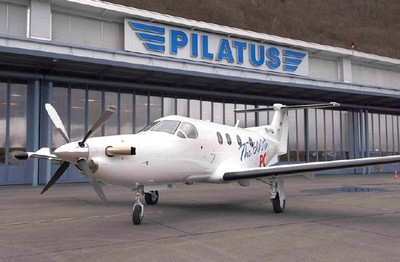Aero-Tips!
A good pilot is always learning -- how many times have you heard
this old standard throughout your flying career? There is no truer
statement in all of flying (well, with the possible exception of
"there are no old, bold pilots.")

Aero-News has called upon the expertise of Thomas P. Turner,
master CFI and all-around-good-guy, to bring our readers -- and us
-- daily tips to improve our skills as aviators. Some of them, you
may have heard before... but for each of us, there will also be
something we might never have considered before, or something that
didn't "stick" the way it should have the first time we memorized
it for the practical test.
Look for our daily Aero-Tips segments, coming each day to you
through the Aero-News Network.
Aero-Tips 08.21.06
 Turbine time. It's the elusive
credential needed to put you over the top for an airline or
corporate interview. It's what you'll need to fly a personal
turboprop or Very Light Jet (VLJ). But how can you log that
elusive (and expensive!) turbine time?
Turbine time. It's the elusive
credential needed to put you over the top for an airline or
corporate interview. It's what you'll need to fly a personal
turboprop or Very Light Jet (VLJ). But how can you log that
elusive (and expensive!) turbine time?
A reader asked me this question. He flies a high-performance,
fixed-gear single. His business gives him the opportunity to travel
(hence the airplane), and he's looking for a larger airplane to
meet passenger and equipment-carrying requirements. He's narrowing
his search to the single-engine turboprops (the TBM850 and PC-12
are tops on his list), and realizes it'll be some time before he
can fly it as pilot-in-command (PIC). Business arrangements may
permit co-owning the airplane with another company that employs a
pilot...so he hopes to log right-seat time toward flying it
himself.
Obstacles
I explained that this is a more difficult goal than he suggests.
There are some obstacles standing between him and the left seat of
a turboprop.
- Federal Air Regulations (FARs) permit him to log time in the
airplane only when he is the "sole manipulator of the
controls".
- He will need to obtain his complex and (perhaps) high
performance endorsements (there's debate about the need for the
"high performance", because that applies to piston powerplants, not
turbines), and the high altitude endorsement, before he can operate
as PIC.
- If another pilot is PIC and a current flight instructor, my
reader is able to log "dual instruction received" in the turbine
airplane (assuming the CFI is actually providing instruction, and
logs the dual in my reader's logbook).
- My reader cannot log second-in-command (SIC) time, even if
company or insurance requirements call for two-pilot operation,
because these airplanes do not require a second pilot under
FARs.
The bad news
The bad news is that any insurance would likely be void if my
reader flies as sole manipulator of the controls (given his lack of
experience), or if the PIC conducts dual flight instruction in the
airplane. Hence it appears there's no way for my reader to log any
experience, so he'll never be able to qualify as turbine PIC under
an insurance policy.
Strategy
Historically pilots have depended on military time to gain
turbine experience, or a long period of gradually moving up through
experience ranks -- from fixed gear to retractable gear to
multiengine to pressurized piston to turbine equipment -- each
presenting it's own "you need experience to fly them, but you can't
get experience without flying them" obstacles.

Barring military service or a long, expensive "prequalification"
for turbines, the only strategy seems to be participation in a
well-defined training regime, including factory-approved training,
a "mentor pilot" who provides loggable dual instruction for the
first hundred hours or more in the turbine type, and a willing
insurance underwriter. And, a few tens of thousands of dollars for
insurance, because such a pilot historically represents a huge risk
for an insurance carrier. Not coincidentally, this is exactly what
the hopeful Very Light Jet (VLJ) manufacturers are proposing for
buyers of their turbine airplanes -- a drawn-out internship to
raise a piston pilot to a jet-captain level of professionalism
through training, testing, and "mentor pilots". It's a long,
expensive road... but it's the only way to "get there from
here".
Aero-tip of the day: Prepare a detailed
"transition plan" to move into turbine equipment, and realize that
there is a significant training commitment associated with being
safe in turbine airplanes.
 ANN's Daily Aero-Linx (04.15.24)
ANN's Daily Aero-Linx (04.15.24) Classic Aero-TV: 'No Other Options' -- The Israeli Air Force's Danny Shapira
Classic Aero-TV: 'No Other Options' -- The Israeli Air Force's Danny Shapira Aero-News: Quote of the Day (04.15.24)
Aero-News: Quote of the Day (04.15.24) Airborne 04.16.24: RV Update, Affordable Flying Expo, Diamond Lil
Airborne 04.16.24: RV Update, Affordable Flying Expo, Diamond Lil ANN's Daily Aero-Term (04.16.24): Chart Supplement US
ANN's Daily Aero-Term (04.16.24): Chart Supplement US





